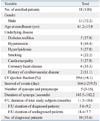1. Task Force for the Diagnosis and Management of Syncope. European Society of Cardiology (ESC). European Heart Rhythm Association (EHRA). Heart Failure Association (HFA). Heart Rhythm Society (HRS). Moya A, et al. Guidelines for the diagnosis and management of syncope (version 2009). Eur Heart J. 2009. 30:2631–2671.
2. Brignole M, Ungar A, Bartoletti A, Ponassi I, Lagi A, Mussi C, et al. Standardized-care pathway vs. usual management of syncope patients presenting as emergencies at general hospitals. Europace. 2006. 8:644–650.

3. Suzuki T, Matsunaga N, Kohsaka S. Diagnostic patterns in the evaluation of patients hospitalized with syncope. Pacing Clin Electrophysiol. 2006. 29:1240–1244.

4. Edvardsson N, Frykman V, van Mechelen R, Mitro P, Mohii-Oskarsson A, Pasquié JL, et al. Use of an implantable loop recorder to increase the diagnostic yield in unexplained syncope: results from the PICTURE registry. Europace. 2011. 13:262–269.

5. Lombardi F, Calosso E, Mascioli G, Marangoni E, Donato A, Rossi S, et al. Utility of implantable loop recorder (Reveal Plus) in the diagnosis of unexplained syncope. Europace. 2005. 7:19–24.

6. Shin DH, Kim JS, Park JW, Yim HR, Kim JH, Lee SM, et al. The use of an implantable loop recorder in patients with syncope of unknown origin. Korean Circ J. 2008. 38:205–211.

7. Kang GH, Oh JH, Kim JS, On YK, Song HG, Jo IJ, et al. Diagnostic patterns in the evaluation of patients presenting with syncope at the emergency or outpatient department. Yonsei Med J. 2012. 53:517–523.

8. Pires LA, Ganji JR, Jarandila R, Steele R. Diagnostic patterns and temporal trends in the evaluation of adult patients hospitalized with syncope. Arch Intern Med. 2001. 161:1889–1895.

9. Boersma L, Mont L, Sionis A, García E, Brugada J. Value of the implantable loop recorder for the management of patients with unexplained syncope. Europace. 2004. 6:70–76.

10. Vitale E, Ungar A, Maggi R, Francese M, Lunati M, Colaceci R, et al. Discrepancy between clinical practice and standardized indications for an implantable loop recorder in patients with unexplained syncope. Europace. 2010. 12:1475–1479.

11. Brignole M, Menozzi C, Moya A, Garcia-Civera R, Mont L, Alvarez M, et al. Mechanism of syncope in patients with bundle branch block and negative electrophysiological test. Circulation. 2001. 104:2045–2050.

12. Furukawa T, Maggi R, Bertolone C, Fontana D, Brignole M. Additional diagnostic value of very prolonged observation by implantable loop recorder in patients with unexplained syncope. J Cardiovasc Electrophysiol. 2012. 23:67–71.

13. Krahn AD, Klein GJ, Yee R, Hoch JS, Skanes AC. Cost implications of testing strategy in patients with syncope: randomized assessment of syncope trial. J Am Coll Cardiol. 2003. 42:495–501.

14. Giada F, Gulizia M, Francese M, Croci F, Santangelo L, Santomauro M, et al. Recurrent unexplained palpitations (RUP) study comparison of implantable loop recorder versus conventional diagnostic strategy. J Am Coll Cardiol. 2007. 49:1951–1956.
15. Arzbaecher R, Hampton DR, Burke MC, Garrett MC. Subcutaneous electrocardiogram monitors and their field of view. J Electrocardiol. 2010. 43:601–605.









 PDF
PDF ePub
ePub Citation
Citation Print
Print



 XML Download
XML Download